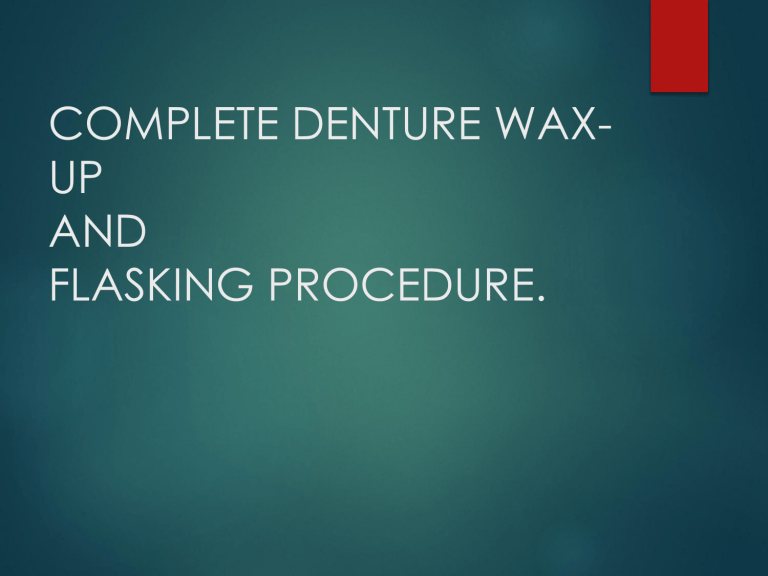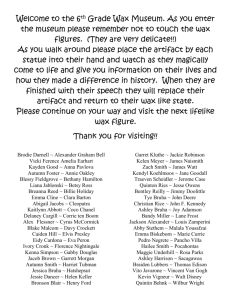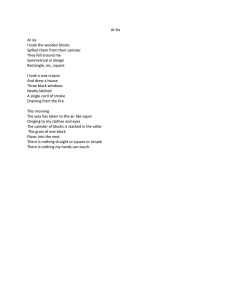introduction to prosthodontics 2nd yr.
advertisement

COMPLETE DENTURE WAXUP AND FLASKING PROCEDURE. Waxing-up is the contouring of the trial denture base into the desired form to produce a denture base that reproduces the contour of the original tissues in the dentulous mouth in order to : 1-produce a pleasing natural appearance. 2-aid in retention and stability of the dentures. Waxing may be accomplished either by placing a piece of soften base plate wax to the base and gradually carving it down to the desired form or by depositing molten wax in the proper area to build up the desired form so that: 1-the anterior portion of the maxillary denture base should be shaped so that together with the teeth, it provides a pleasing form for the lip. 2-the contour of the mandibular denture in the anterior region is relatively straight. 3-the form of buccal flange from the premolar backward should face downward and outward for maxillary and upward and outward for mandibular. This contour allows the buccinator muscle to lie against the denture and aids in its retention and stability 4-the contour of the lingual surface in the anterior region should be straight and slope to the lingual border. The contour of the lingual surface in the premolar and molar region ( retromylohyoid region) as a concave surface in this area provides space for the tongue 5-any excess wax around the teeth is removed. The remaining wax is carved at the cervical line of artificial teeth to simulate the natural appearance of the gingival margin and gingival papillae. 6-the region of attached gingival may be stippled to produce a finished denture whose surface show an a "orange-peel effect". 7-the wax above the roots should be contoured to simulate the root prominences present in dentulous mouths. 8-the palatal surface of the maxillary trial denture base should be waxed to a nearly uniform thickness of 2.5 mm. 9-the wax at the borders is contoured as in the impression to produce a perfect peripheral seal. 10-finally,wax solvent is used to remove any excess wax from the surface of the teeth. PROCESSING OF DENTURE Flasking. Wax elimination. Packing and curing. Processing Techniques Compression Microwave Injection Processing Technique Compression molding Conventional More Time method than 60 years consuming Master cast Mounting (with casts already indexed on the bases) * Trim base of cast to the dimension that will fit in the processing flask prior to indexing 1 2 3 Split mold Denture flask (ejector-type, three piece) 1. The drag (bottom) 2. The cope (middle) 3. The cap (thin top) Split mold STIPLE WAX ON FLANGES. TINFOIL BASE OF CAST. CHECK CLEARANCE WITH FLASK. CHECK PERIPHERAL CLEARANCE. LOWER HALF OF FLASK POURED. POURING STONE FOR THE UPPER HALF. Maxillary denture with the index in place and embedded in the flask Soap, or a gypsum separator, is used between the two pours of dental stone in the lower and upper portions of the flask. CLEAR THE LINGUAL TROUGH. CLEAR THE TEETH. •The surface of the third layer is left slightly rough to hold the fourth investment layer in position. •Tinfoil separating medium is painted on the third layer. •The fourth investment layer is used to fill the remainder of the flask. The lid of the flask is pressed into place while the investing stone is still soft. The flask is set aside for min. 1 hr. before the wax elimination. Second pour (upper half of flask) STONE CAP UPPER HALF STONE STONE CAST LOWER HALF STONE COMPLETED FLASKING. STONE CAP UPPER HALF STONE STONE CAST LOWER HALF STONE COMPLETED FLASKING FOR THE MANDIBULAR COMPLETE DENTURE. Processing Technique Microwave System (GC America Inc.3737 W. 127th Street, Alsip, IL 60803) Use the split mold technique to form molds ACRON MC microwave cured acrylic Need special flask (resin + small metal screws) One minute microwaved to soften wax Eliminate wax from mold Three minute curing in microwave Leave 15-20 mins before opening flask Less VDO increase?? Easy to use Low water absorption Microwave system Three minute curing in microwave Fast, easy to use Allows more efficient use of time Produces Denture Interim denture in short processing time repair partial Processing Technique 3. Injection 3.1 Ivocap injection system, Ivoclar, Vivadent, Inc, Amherst, NY) In Mid 1970 VDO is more stable compare with conventional Flask is closed during the procedure Processing Technique 3. Injection 3.2 Success System (Dentsply, International, Inc, York, PA) PMMA 90 Lucitone 199 PSI, use heat-polymerized resin Master cast removed from invest material Finished denture






